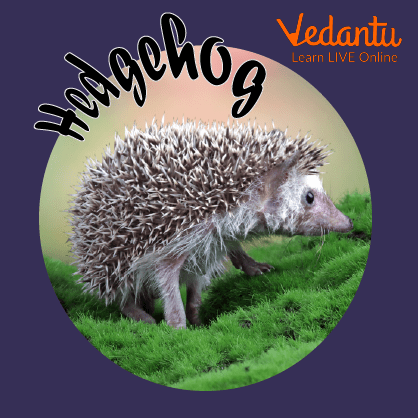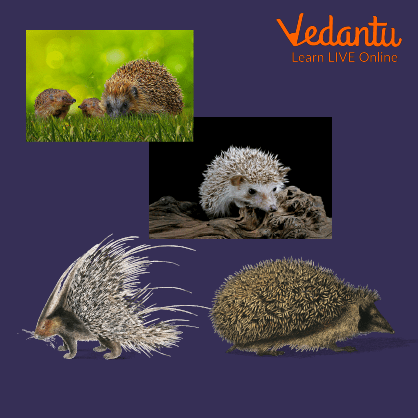




Key Characteristics and Importance of Hedgehogs in EVS
Have you ever seen an animal full of spines? No, they are not porcupines. In this article, we are going to study the animal with lots of spines, known as a Hedgehog. Hedgehog animals are small mammals found in Europe, Africa and Asia. They are also kept as pets in some parts of the world and then known as the domesticated hedgehog. The spines of hedgehogs are made up of keratin; it is the same material found in human hair and nails. These spines help them to defend against predators. Sometimes people might call porcupines hedgehogs, but hedgehogs and porcupines are different animals.
Hedgehog Habitat
Let's see first where hedgehogs live. Hedgehogs are mostly found in deserts, forests, grasslands, marshes and gardens. During the daytime, they sleep under leaves or in holes and are active at night eating insects, slugs, spiders, small reptiles and fallen fruit.
Some domesticated hedgehogs have hair instead of spines; therefore, they are called hairy hedgehogs. They look like rats. They reproduce between April and September. But the activity is maximum in May and June.
They have their hair colour ranging from white to brownish red to black. Their hair may be soft or very rough. Their size can be similar to the size of a mouse or as long as 18 inches (46 centimetres).

Hedgehog Animal
Hedgehog Animal
Some hedgehog animals are called spiny hedgehogs as they have thousands of sharp spines on their bodies. The spines cover everything of their body except the underside, legs, face and ears. The spines are cream in colour with brown and black bands. Spiny hedgehogs curl their body into a ball when threatened, so only their spines are showing. Through spines, hedgehogs protect themselves from other wild animals. A group of hedgehogs is called an array, but It is extremely rare to see multiple hedgehogs together in one place other than when mating.
The pet hedgehog's diet mainly consists of high-quality hedgehog food mixed with high-quality, low-fat cat food. Gut-loaded insects, such as mealworms and crickets, are supplement foods that can be used in small amounts, two to three times a week. Hedgehogs are lactose intolerant, so milk should never be left out for them. The water is perfectly fine. When a hedgehog smells or tastes something really strong, it attempts to cover itself in foamy saliva, much like a cat cleaning itself. This is called self-anointing.
The hedgehog spikes make their unique animals. The hedgehog is a spiny mammal of the subfamily Erinaceinae in the eulipotyphla. These animals are most famous for their prickly spines. They depend on their spines for defence. Hedgehogs are classified into five genera and seventeen species. Hedgehogs have between 5000 and 7000 spines on their back, which they may raise and drop in response to danger. Each spine lasts about a year before dropping out and being replaced. Globally, there are around 15 different species of hedgehog found.
The Reason Why They are Called Hedgehogs
The ‘Hedge’ part of their name comes from where they build their nests, hedges, bushes and shrubs and the ‘hog’ part comes from the small snorting/grunting sound they make, similar to a pig/warthog. The hedgehog was not always called a hedgehog. Earlier, they were called Urchins, which led to the naming of Sea Urchins.

A Closer View of a Hedgehog
Interesting Facts about Hedgehogs
Interesting facts about hedgehogs are as follows:
Hedgehogs are nocturnal, which means they spend the day sleeping and only emerge at night.
Hedgehogs' long snout is advantageous since it aids in hunting. It even gets in front of their mouths by making it simpler for them to find their main sources of food, which are insects, worms, caterpillars and berries.
As their eyesight is not particularly excellent, they mostly rely on their hearing and scent to hunt instead, however they can see very well in the dark.
There aren’t just one species of hedgehog: There are 15 different species of hedgehog in the world. Each of them looks similar but has small charismatic and habitual differences. The UK only has one native species, the European Hedgehog.
Hedgehogs are solitary animals that leave their mother's care just four to seven weeks after hatching. Except for partnering up to mate with another hedgehog, they live entirely alone.
Summary
Hibernation is the process that allows an animal to use less energy when food is hard to find. Hedgehogs use the fat built up in their bodies to survive while hibernating. Some spiny hedgehogs' hibernation period is in the winter. The hedgehog spends the day during their hibernating phase sleeping in a carefully constructed nest in dense undergrowth, under a shed, amid piles of leaves and unlit bonfires. They never sleep or hibernate outside a nest.
FAQs on What is a Hedgehog?
1. What kind of animal is a hedgehog?
A hedgehog is a small, nocturnal mammal known for its coat of stiff, sharp spines. Despite their appearance, they are not rodents; they belong to the subfamily Erinaceinae. They are found in parts of Europe, Asia, and Africa.
2. Why is an animal called a hedgehog?
The name 'hedgehog' is a great example of how an animal's name can describe its behaviour. It comes from two words:
- 'Hedge' because they often hunt and build their nests in garden hedges and undergrowth.
- 'Hog' because they make pig-like snorting and grunting sounds as they search for food.
3. What do hedgehogs eat in the wild?
Hedgehogs are primarily insectivores, which means their main diet consists of insects. They are very helpful to gardeners because they eat common pests. A typical hedgehog diet includes beetles, worms, caterpillars, snails, and slugs. They may also occasionally eat fallen fruit, fungi, or small eggs.
4. How do hedgehogs protect themselves from danger?
A hedgehog’s main form of defence is its coat of around 5,000 to 7,000 sharp spines. When it senses a threat from a predator like a fox or a badger, it will curl itself into a tight ball. This action causes all its spines to point outwards, creating a spiky, impenetrable shield that is very difficult for a predator to bite or attack.
5. Are the spines on a hedgehog poisonous?
No, the spines on a hedgehog are not poisonous or venomous. They are hollow hairs made stiff with keratin, the same protein that makes up human hair and fingernails. While they are very sharp and can cause a painful prick, they do not contain any poison.
6. What is the difference between a hedgehog and a porcupine?
While both are spiky mammals, hedgehogs and porcupines are not closely related and have key differences:
- Defence: A porcupine's quills are longer, have barbs, and detach easily to stick into a predator. A hedgehog's spines remain attached to its body.
- Family: Porcupines are large rodents, whereas hedgehogs are smaller mammals from a different order.
- Behaviour: Hedgehogs curl into a ball for defence, while porcupines will charge backwards into a threat.
7. Why is a hedgehog not considered a type of pig?
A hedgehog is not a type of pig, despite the 'hog' in its name. This part of its name only refers to the funny, pig-like grunting sounds it makes while foraging. Biologically, hedgehogs are small insect-eating mammals, while pigs are large, even-toed ungulates. They belong to completely different families in the animal kingdom.
8. Can a hedgehog be kept as a pet?
Some species, like the African Pygmy hedgehog, are bred to be kept as pets, but they require a lot of special care. They are nocturnal (active at night), need a controlled temperature, and have a specific diet. Their spiky nature also means they need to be handled carefully and gently. It is often illegal to keep a wild European hedgehog as a pet.









